by T. Sabaratnam, June 2004
Chapter 7
Original index to series
Original Chapter 8
Finding Scapegoats
Jayewardene was disturbed by the criticism of the attacks on Tamils by many Western countries and international human rights watchers. Indira Gandhi’s telephone call on Thursday, 28 July evening upset him more. As mentioned earlier he, asked Ranil Wickremesinghe to summon his confidants, Gamini, Lalith, Anandatissa and Festus. During the lengthy midnight session, they decided on two things: ask arms from friendly countries and to distance themselves from the violence. I have already dealt with the outcome of Jayewardene’s request for arms.
The cover up was decided to pass on the blame for the violence to others: the leftists – the Communist Party (CP), Nava Sama Samaja Party (NSSP) and the Janatha Vimukthi Peramuna (JVP). Blaming the communists would silence the Western countries. That would also weaken the voice of the human rights organizations, which Jayewardene had already dubbed as communists and communist ‘fellow travellers.’
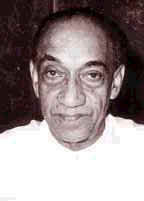
JR Jayawardene
The cover up necessitated a change in the explanation about the cause of the riots. The government had maintained that the riot was the result of a “spontaneous outburst of Sinhala wrath” to the killing of Sinhala soldiers at Thirunelveli. Now this explanation have to be altered to “planned overthrow of the democratically elected government.”
The first comment on the riots came from cabinet spokesman Minister of State Anandatissa de Alwis after the weekly cabinet meeting on Wednesday, 27 July, afternoon. He told the press conference held after the cabinet meeting – it was called the post cabinet briefing – that the violence was the reaction of the Sinhala people who had endured a series of murders committed by the Tamil terrorist groups.
Jayewardene, in his address to the nation on Thursday, July 28, struck to the line that the violence was a Sinhala reaction. He said, “…the Sinhala people have themselves reacted…”
Prime Minister Ranasinghe Premadasa, who addressed the nation on Friday, 29 July attributed the violence to “wild rumours.”
Thus, till Friday evening, there was no talk about an organized plot to overthrow the government. On Saturday, 30 July, the change was brought about. Anandatissa de Alwis told the media the riots was planned and implemented by three leftist parties. He followed that up with an address to the nation over the radio and television. He identified the three parties as the JVP, the CP and the NSSP.
Anandatissa de Alwis said that there was a ‘master plan’ and that ‘the minds of certain foreign elements’ were behind it. In a later interview, he identified the ‘foreign mind’ as the KGB, the Soviet Union’s intelligence agency. Mathew identified it as the ‘dirty Indian hand.’
The planning group that decided on the cover up, it was later revealed, had debated for a long time whether to blame the Soviet embassy in Colombo and extradite the Soviet ambassador. The idea was dropped because some ministers felt that the government would not be in a position to substantiate that charge.
Anandatissa announced that the plot comprised three phases. They were:
First phase: To induce violence between Sinhalese and Tamils.
Second phase: To induce violence between Sinhalese and Muslims.
Third phase: To induce violence between Buddhists and Sinhala Christians.
Radio and television announced the news of the leftist plot that day itself and the newspapers the following day. They also announced the proscription of the CP, NSSP and JVP for the duration of the emergency and the promulgation of some draconian provisions of the Public Security Act, which prescribed severe penalties, including death or life imprisonment and loss of civic rights, for those entering or having contact with the proscribed parties.
The ban came into effect on 30 July and leaders of the proscribed parties were arrested the same day. H. G. S. Ratnaweera, K. P. Silva and D. E. W. Gunasekera of the CP, and Vasudeva Nanayakara and Dr. Wickramabahu Karunaratne of the NSSP were arrested. Lionel Bopage, general secretary of the JVP, and other office-bearers of the JVP were arrested and detained on the notorious fourth floor. JVP leader Rohana Wijeweera went underground.
On Thursday morning, 4 August, in his address to the government parliamentary group, Jayewardene called the plot the Second Naxalite Plot. He added another phase and made it a 4-phase conspiracy. The fourth phase was the overthrow of the Government by the group in the armed services sympathetic to the JVP.
The intrigue behind the Naxalite plot has been carefully investigated and documented by researchers. Ratnatunga in his book Politics of Terrorism: Sri Lankan Experience says that information about the plot was given to Jayewardene by Deputy Inspector General of Police Ernest Perera on Thursday, 28 July night, the night Jayewardene addressed the nation. Ernest Perera met Jayewardene in the company of Inspector General of Police Rudra Rajasingham.
According to Rajan Hoole, Ernest Perera and Rajasingham left Jayewardene’s residence at 9 p.m. after watching his address to the nation in which no mention was made about the plot. Jayewardene summoned Ernest Perera at 6 a.m. on Friday, 29 July, and got him to dictate a statement about the plot to his private stenographer, J. A. Paulaz. Jayewardene made photocopies of the statement and gave them to the service chiefs and to Rao, who met him over breakfast.
The handing over of a copy of the statement to Rao makes the purpose of the cover up clear. The announcement of the plot on Saturday by Anandatissa de Alwis was intended to silence Western critics. Through the Naxalite Plot story, Jayewardene told the world that he was not the offender, but the offended. He told the world that it was his government that was in danger of being overthrown. He also said that he was not certain of the loyalty of at least a section of the troops. Through the Naxalite plot story, he explained his four-day delay in addressing the nation. He told the world that he delayed his address because he was not sure of himself.

Rohana Wijeweera
The Naxalite Plot story had another important purpose. Bopage told investigators that Jayewardene achieved that purpose by driving Rohana Wijeweera underground. Wijeweera had challenged the 1982 Referendum result in the District Court of Colombo, alleging a number of serious abuses. He had a very strong case. The action was dismissed because Wijeweera failed to answer the interrogatories served on him. The Appeal Court upheld the order of the District Court.
None believed Jayewardene’s conspiracy story. Tamils, Sinhala opposition leaders, foreign correspondents, the international community and human rights watchers saw through Jayewardene’s ruse. John Eliot of the Financial Times called it a ‘crude cover up.’ Amirthalingam, in a letter written to Jayewardene from Chennai, said, “The Tamil people do not believe that Left parties had any hand in the attack on them. They regard this as an attempt to win the support and sympathy of the Western powers.”
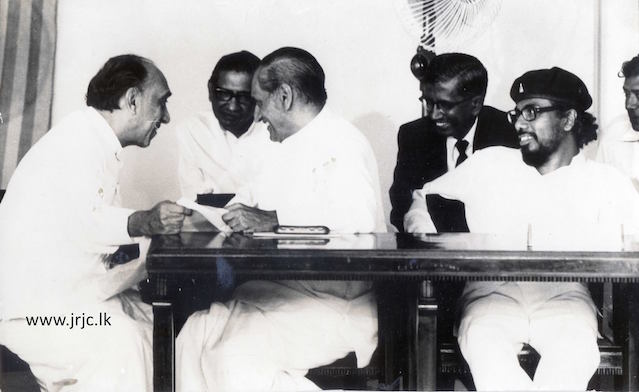
JR (left), Wijeweera (right)
Sirimavo Bandaranaike in an interview to Asiaweek of 12 August 1983 dismissed the ‘conspiracy theory.’ She said, “It is definitely racial. Anyone who says the violence was anything else but racial is living in a fool’s paradise.” She also blamed the Jayewardene regime for the violence.
The International Commission of Jurists (ICJ) spotlighted the ‘shortage of facts’ to support the Naxalite plot theory. It said the Tamils, the affected party, blamed the government for organizing the attacks. It also commented that most of the Tamil people do not blame the entirety of the Sinhala people.
Prof. Gananath Obeysekera in Political Violence and the Future of the Democracy offers a similar view. He said, “Virtually every Tamil I met was of the opinion that the violence against them was organized by the government.”
Investigations proved abortive. There was no evidence to establish the Naxalite Plot theory and the leaders of the CP and NSSP were released within two months. The ban on their organizations was removed. But the ban on the JVP continued. Bopage said that the ban against them had been continued because the hearing of the election petition by the District Court and its appeal dragged on. The government said it was continuing the ban on the JVP because Wijeweera was absconding.
D.E.W. Gunasekera, ‘D.E. W.’ for his friends, the current general secretary of the Communist Party and Minister of Constitutional Affairs, concluded the article I quoted in the last chapter thus,
“We were left there (Negombo Prison) for 56 days and released honourably exonerated. Next morning, after our release, J. R. Jyewardene had the guts to telephone Pieter Keuneman and K. P. Silva and invite them for talks, seeking advice on the solution to the ethnic problem. Of course, that was J.R. “His Excellency, on that day, was so generous as to step out of the Ward Place house to greet them, for his conscience would have pricked him to confess his guilt for what he had done in banning the party and imprisoning its leaders for no reason. “That was J.R’s style of governance. Of all the misdeeds of J. R. the blackest was the Black July for which the nation suffers to date.”
Sixth Amendment
The Jayewardene regime, while trying to cover up its attacks on the Tamil people, continued with its program for their marginalization. The program was carried out in all spheres – economic, employment, education and politics.
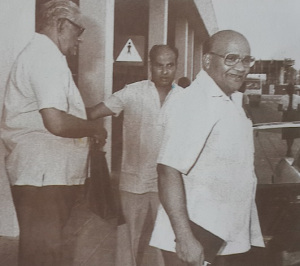
M. Sivasithamparam, A. Amirthalingam and other parliamentarians leaving Parliament
In the economic sphere, three actions of the government need to be recorded. The first was the attempt to wrest the Pettah wholesale market from the Tamils. The second was to hand over shares in the destroyed Tamil business houses to the Sinhalese. The third was to take over the Tamil-owned property with the intention of giving them to the Sinhalese.
Pettah is the hub of Sri Lanka’s commercial activity. The narrow and stuffy 4th and 5th Cross Streets and Keyzer Street was the centre of the rice and food grains trade. That trade was controlled by Indian and Sri Lankan Tamils. That was the first area of attack by the arsonists on Monday, 25 July, morning. The entire are was ‘a sea of flame’ as a grief-stricken rice merchant called it. The adjoining Main Street and by-streets is the centre of the textile trade. That was also controlled by Tamils. That was the second area of arson. In both areas 442 shops were completely gutted and several men who worked in those shops were murdered.
Lalith Athulathmudali organized an alternative rice wholesale market at Duplication Road. He opened the complex, which had room for 50 wholesale traders, on 3 August and declared that the new market would take away the monopoly the Tamils enjoyed in the rice trade. He accused Tamil traders of profiteering and fixing prices.
Most of the Tamil Pettah merchants have sprung back and currently (in 2004) about 70%- 80% of the rice and textile trades are controlled by them. Muslims have taken over the major portion of the balance.
Anandatissa followed Lalith’s initiative and announced a plan to restructure the ownership of Tamil-owned industries. He said, “Trade Minister has already reorganized rice wholesaling to break the Tamil grip. It is no longer in our interest to allow one community to dominate.” He then announced his plan to restructure the ownership of Tamil business. He announced that Tamils would be denied majority shareholding.
Anandatissa’s plan to take over the control of Tamil-owned industries and the plan to take over Tamil owned property and houses failed because of India’s objection. The government created a new authority called REPIA (Rehabilitation of Properties and Industries Authority) and vested the ownership of all properties and houses abandoned by the Tamils due to the disturbances in it. Amirthalingam and India objected to the taking over of the property. Amirthalingam conveyed to Jayewardene the Tamil fear that the government was trying to expropriate their property.
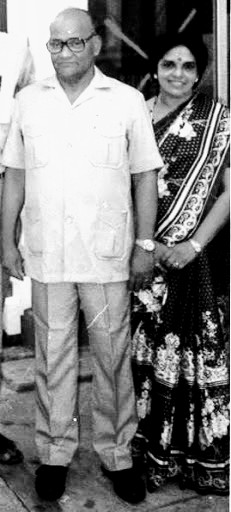
A Amirthalingam & Mangayarkarasi Amirthalingam
Amirthalingam’s letter said, “Tamil people regard this as an attempt to expropriate what the looters have left behind.”
India’s objection compelled the government to climb down. It issued a statement saying that all damaged properties were vested in REPIA in the interest of the Tamils. That action was taken to prevent encroachment, the statement said. I was a beneficiary of India’s objection. When I decided to rebuild my burnt house, I applied to REPIA to reinvest my property to me. It did.
The Jayewardene regime stopped recruiting Tamils to state institutions. It introduced a system of police clearance. Any applicant to a state job was required to produce a letter from the police saying that he is not a supporter of any militant group. The private sector also was discouraged to recruit Tamils.
In the field of education, Tamils schools were neglected. The education department ceased appointing teachers to Tamil schools. The cadre available for Tamil schools was filled with Sinhalese. The department appointed Sinhalese principals to Tamil schools. Kurunegala Tamil Maha Vidyalayam still has a Sinhalese as its principal.
Political marginalization was carried out through the Sixth Amendment to the constitution. It was Jayewardene’s answer to the Tamil demand for a separate state called Tamil Eelam. Jayewardene and other Sinhala leaders never took the reactions of the Tamil people into account. They believed that the only opinion of the majority Sinhalese community mattered and that opinion should be thrust down the throats of the Tamil people.
The Sixth Amendment was drafted in a hurry by the team headed by Athulathmudali. It was sent for the consideration of the Constitutional Court as an urgent bill. The court considered it on 2 August and ruled that two sections were inconsistent with the Constitution and recommended that they be suitably amended.
The cabinet considered the order of the Constitutional Court on 3 August. Jayewardene told the cabinet about his effort to hold an All Party Conference. He said he tried to work out a solution to the Tamil problem through the All Party Conference before he agreed to enact the Sixth Amendment. He said:
I convened a roundtable conference of political parties on July 20. In it I planned to discuss a solution to Tamil problems, including devolving more power to the Development Councils, the withdrawal of the Prevention of Terrorism Act, a general amnesty to all those arrested under that act and the withdrawal of the army from the north. It was unfortunate that all the political parties boycotted the talks and prevented me from discussing a solution to the problems of the Tamils.
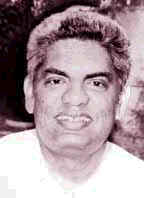
Lalith Athulathmudali
The cabinet decided to keep the two inconsistent sections in the bill. It decided to adopt them in parliament with the two-third majority, which it had. The cabinet also decided to convene parliament the next day, 4 August, to debate the Sixth Amendment.
The weekly post-cabinet press conference was held around noon at the Information Department in Fort. I covered that conference for the Daily News. I had not do so the previous week due to the riots. I covered all but one of the post-cabinet press conferences which were started by Anandatissa de Alwis in 1978 till my retirement at the end of 1997. Anandatissa de Alwis told the media that the Sixth Amendment would be debated to a finish the following day.
Copies of Jayewardene’s statement to the cabinet about the All Party Conference were distributed to the media. Sri Lanka Broadcasting Corporation (SLBC) broadcast the statement that evening and the newspapers printed it the next morning.
Jayewardene presented the Sixth Amendment to the Government Parliamentary Group on the morning of 4 August. That meeting is important for two reasons. Firstly, he presented his Second Naxalite Plot cover up theory, which I had dealt above, at this meeting. Secondly, he indicated to the parliamentary group his decision to marginalize the Tamil moderates and to destroy the militants using the military. He told the lawmakers that he would not talk to the TULF unless it took the oath prescribed by the Sixth Amendment. He also told them that Tamil militants would be destroyed soon.
Parliament met at 2 p.m. on Thursday, 4 August. After the half-hour question time and other normal business, it adopted a government resolution to suspend the standing orders to enable the House to debate the bill to a finish that day itself. Standing orders specify that the House should adjourn at 8 p.m. on Tuesdays, Wednesdays and Thursdays and at 5 p.m. on Friday.
Prime Minister Ranasinghe Premadasa moved the following bill:
“Whereas Sri Lanka is free, sovereign, independent and a unitary state and it is the duty of the state to safeguard the independence, sovereignty, unity and the territorial integrity of Sri Lanka; “And whereas the independence, sovereignty, unity and the territorial integrity of Sri Lanka has been threatened by the activities of certain persons, political parties and other associations and organizations;
“And whereas it has become necessary to prohibit such activities and provide punishments therefore; “The following Article be embodied in the constitution as, “157A. [1]: No persons shall directly or indirectly, in or outside Sri Lanka, support, espouse, promote, finance, encourage or advocate the establishment of a separate state within the territory of Sri Lanka;
“[2] No political party or other association or organization shall have as one of its aims or objects, the establishment of a separate state within the territory of Sri Lanka;
“[3] Any person who acts in contravention of the provision of paragraphs [1] shall, on conviction by the Court of Appeal, after trial on indictment and according to such procedure as may be prescribed by law, (a) be subject to civic disability for such period not exceeding seven years as may be determined by such Court;
(b) forfeit his movable and immovable property other than such property as is determined by an order of such court as being necessary for the sustenance of such person and his family; not be entitled to civic rights for such period not exceeding seven years as may be determined by the such court;
(c) and if he is a member of parliament or a person in such service or holding such office as is referred to in paragraph [1] of Article 165, cease to be such member or to be in such service or to hold such office.
Section (4), which contains 12 subsections, prescribed the procedure for the proscription of the political parties and the disabilities to which persons are subject to for the contravention of the above sections.
Article 165 (1) of the constitution lays down that every public officer, judicial officer, local government, public corporation officials and others required to take official oath or affirmation should take the oath or affirmation to uphold the constitution. The amendment bill prescribed that all these categories of persons should take a fresh oath or affirmation of allegiance to the constitution and officers who failed to do so would lose their jobs.
The amendment laid down the format of the oath of allegiance, to be included in the constitution as the Seventh Schedule. It reads:
“I, … do solemnly declare and affirm/swear, that I will uphold, and defend the constitution of the Democratic Socialist Republic of Sri Lanka and that I will not, directly or indirectly, in or outside Sri Lanka, support, espouse, promote, finance, encourage or advocate the establishment of a separate State within the territory of Sri Lanka.”
Taking this oath meant upholding and defending the unitary character of the Sri Lankan state for Article 2 of the Constitution states:
The Republic of Sri Lanka is a Unitary State.
Premadasa delivered a lengthy speech introducing the Sixth Amendment. He set the trend for that night’s Tamil baiting. He traced the history of the Sinhala race, eulogized its historical and civilization achievements and extolled the special role Gautama Buddha gave to Sinhala Buddhists in preserving and protecting Buddhism. He declared the Sinhala race had beaten back repeated Tamil invasions and proclaimed that the Sinhala people would never be beaten. Premadasa told the Sinhala people that their spontaneous outburst of anger was understandable. Now that they had given vent to their fury, they should calm down. The new constitutional amendment would put an end to terrorist provocations, he said.
Premadasa was particularly harsh on the TULF. He said the TULF and its leader Amirthalingam should fall in line with the government and stop its duplicity – showing a sweet face in the south and instigating terrorism in the north. The Daily News headlined its parliamentary report, “End of the Road for TULF- PM.” Mathew, Athulathmudali, Gamini Dissanayake and Gamini Jayasuriya continued in that vein. They all maintained that the Sinhala people had reacted violently to the killing of the 13 soldiers.
Mathew advanced two arguments to support the banning of the TULF. Firstly, he argued that the Sinhalese as the majority community should rule the country. For that purpose, he adopted the argument of Malaysian rulers, particularly that of Dr. Mahathir Mohamed’s Bhumi Putra (Sons of the Soil) policy.
Mahathir argued that the Chinese and Indians of Malaysia, if forced to leave, had an alternative home to go, but Malays had no such place. He said that a community that had no place to go are the ‘true sons of the soil.’ And such community should enjoy a predominant place in the country.
Mathew told parliament, “Seventy percent of the people in this country are Sinhala people. In Malaysia, Malays formed only 53 percent of the population… If Sinhalese are a majority race they should be allowed to rule the country.”
From the position of the right of the Sinhala people to rule the country Mathew developed the principle that, if the minority community refused to fall in line with the majority community, the majority community had the right to use violence to subdue the minority community. He fortified this argument by citing the 1969 anti-Chinese riots in Malaysia. He said, “The Chinese of the country acted high-handedly and the Malays had patience only for six days before taking action. But the Sinhalese people of this country had been patient for 10 years.”
Gamini Jayasuriya, Minister of Agriculture, took off from where Mathew ended. He said, “The immediate cause of the recent outburst of violence is not an independent or spontaneous act. It was the climax of the long drawn-out and well planned series of treacherous acts over the years committed by the terrorists of the North.”
Finance Minister Ronnie de Mel made a dissenting speech. He said the riots had damaged the economy. Then he said those who damage the economy were also traitors like those who advocate the division of the country. He said, “I do not know who does greater damage to the country. Is it those who advocate the division of the country or those who destroy the economy? I think both groups are traitors to the country and they should be punished.”
Except for two lone voices of reason, the rest of the 13 hours of the debating time was wasted in calling the TULF and its leader Amirthalingam traitors and provocateurs who were misleading Tamil youth. They wer charged with planting the poisonous Eelam idea in the minds of the young people.
Amirthalingam and other TULF lawmakers were not present in parliament. They were in Vavuniya. The TULF’s annual convention was being held in Mannar from 21-23 July and shifted to Vavuniya on 25 July when the country erupted. They stayed there till 10 August. Amirthalingam and Sivasithamparam had no place to return to in Colombo. Amirthalingam’s official residence was attacked on 25 July and Sivasithamparam’s residence was burnt on 24 night. Sivasithamparam’s wife and children escaped by scaling the wall to their neighbour’s home from where they went to a refugee camp.
On 10 August Amirthalingam returned to Colombo riding on the pillion of the motorcycle of one of his trusted friends and left to Chennai the next day. Before emplaning, he sent a telegram to the Secretary General of the United Nations Organization, urging him to send a peace-keeping force to Sri Lanka to safeguard the Tamils.
Thondaman was the only minister who spoke against the Sixth Amendment. He defended Amirthalingam and the TULF. He gave a detailed account of the various attempts Amirthalingam had made to work out a solution to the ethnic problem. He blamed the Sinhala leadership for its failure to respond positively to his efforts.
Thondaman told parliament that the adoption of the amendment would result in the TULF hardening its attitude even further. He said that, if the government was interested in any solution to the Tamil problem, then it should be in a position to talk to the Tamil moderates, the TULF.
The amendment would prevent that.
He said, “If you proscribe the TULF and force its MPs to quit parliament, then you will have no one to talk to. Maybe, you will have to talk to intermediaries. Proscribing the TULF would also completely estrange the Tamils.” Thondaman issued a statement on 2 August in his capacity of President of the Ceylon Workers Congress in which he maintained the riots were well planned. The relevant part of the statement reads:
In our thinking it was the work of well organized groups who had gone on the rampage, rioting, looting and setting fire. It is more than unfortunate that these elements of disaster, these squads of goondas and rabble rousers have been allowed to parade the streets freely, causing havoc and inflicting misery of such proportions with impunity.
Sarath Muttetuwegama, the lone Communist Party member in parliament, told the House that the riots were state-sponsored. “The State apparatus was used,” he said. Then turning to Thondamam who was seated in the government front bench, Muttetuwegama quoted the last line of his statement and asked, “I beg the Honourable Minister to tell this House whom he was blaming when he said,’goondas and rubble rousers have been allowed to parade the streets. Was it we of the Left parties who allowed the goondas to roam the streets with impunity? Or was there somebody else, some other authority who could have stopped it? You had better tell this House what you really meant when you made the statement?”
Parliament passed the Sixth Amendment at 4 a.m on 5 August after a 13-hour debate and Indira Gandhi called Jayewardene for the second time around 4 p.m.
Indira Gandhi’s call made Hameed’s warning at the cabinet meetings of 27 July and 3 August prophetic. Hameed warned the cabinet on both occasions that the Sixth Amendment would drive the TULF away from parliament and involve India in working out a solution to the Tamil conflict. And India got involved even before the TULF decided not to take the oath of allegiance to the unitary constitution. TULF took that decision on 6 August.